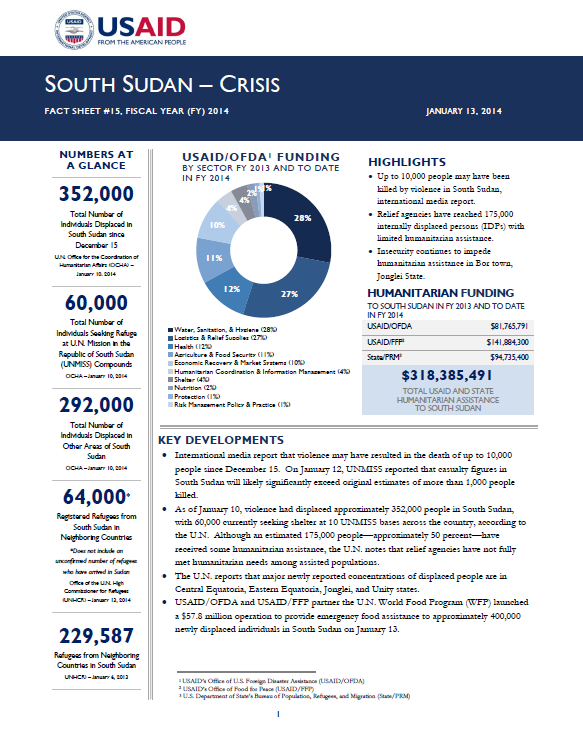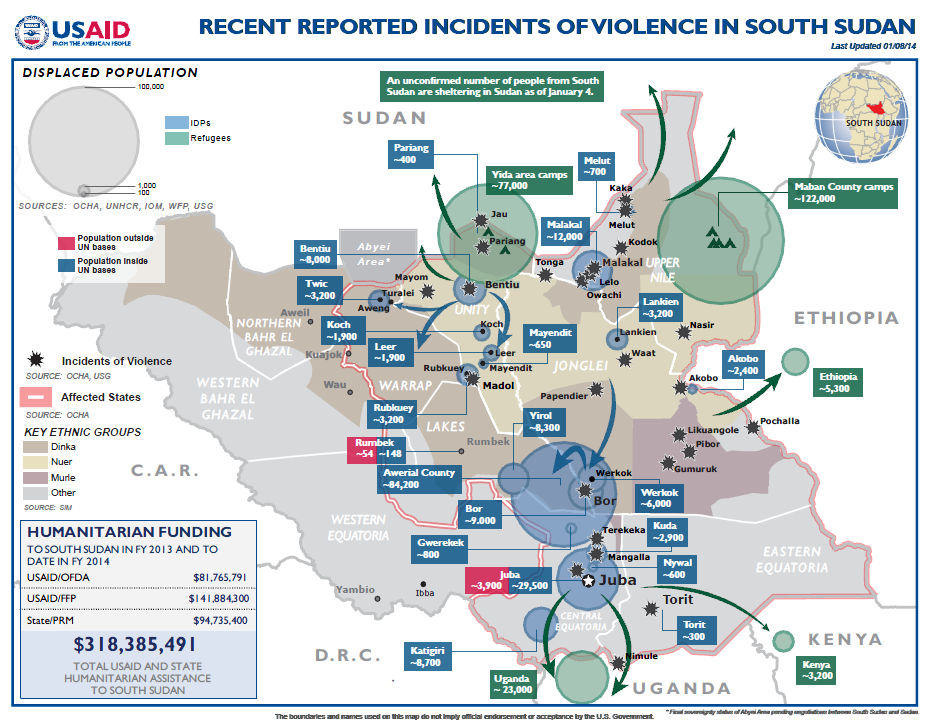- What We Do
- Agriculture and Food Security
- Democracy, Human Rights and Governance
- Economic Growth and Trade
- Education
- Ending Extreme Poverty
- Environment and Global Climate Change
- Gender Equality and Women's Empowerment
- Global Health
- Water and Sanitation
- Working in Crises and Conflict
- Disaster Assistance
- Political Transition Initiatives
- Conflict Mitigation and Prevention
- Countering Violent Extremism
- Disaster Risk Reduction
- Peacebuilding and Reconciliation
- Providing Safe & Secure Environments for Development
- Recovering From Crisis
- Resilience
- Tech Challenge for Atrocity Prevention
- World Humanitarian Day
- U.S. Global Development Lab
February 4, 2014
Numbers At A Glance
743,400
85,200
658,200
130,400
230,200
Humanitarian Funding:
To South Sudan To Date In FY2013 and FY2014:
| USAID/OFDA | $86,383,207 |
| USAID/FFP | $141,884,300 |
| State/PRMDoD | $94,735,400 |
| TOTAL | $323,002,907 |
Highlights
U.N. releases revised South Sudan Crisis Response Plan, requesting $1.27 billion to meet the needs of an estimated 3.2 million people through June.
Approximately 3.2 million South Sudanese are in need of emergency food assistance.
Clashes persist in some areas of South Sudan, while Bentiu, Bor, Malakal, and Juba towns remain calm.
KEY DEVELOPMENTS
Population displacement continues to increase as insecurity persists across South Sudan, with violence displacing nearly 874,000 people—including internally displaced persons (IDPs) and refugees—since December 15, according to the U.N.
The U.N. reports that humanitarian agencies continue to face operational challenges reaching conflict-affected populations due to ongoing fighting and targeting of humanitarian assets and operations by Government of the Republic of South Sudan (RSS) forces and opposition groups. Between December 15, 2013, and January 31, 2014, 95 incidents directly affected humanitarian operations, 82 percent of which included violence against humanitarian personnel or assets, according to the U.N. The majority of reported incidents occurred in Jonglei, Unity, and Upper Nile states.
On February 3, the U.N. released a revised South Sudan Crisis Response Plan, requesting $1.27 billion to respond to urgent needs among approximately 3.2 million conflict-affected, displaced, and food-insecure people, including an anticipated 1 million IDPs, through June. The revised plan reflects increased humanitarian needs since the U.N. released the December 31 plan, which requested $209 million based on a planning figure of 400,000 IDPs between January and March.
SITUATION, DISPLACEMENT, AND HUMANITARIAN NEEDS UPDATE
Violence has internally displaced an estimated 743,300 people throughout South Sudan, and approximately 130,400 people have fled to neighboring countries since December 15, according to the U.N. While the majority of displaced populations have fled to rural areas, approximately 85,200 people are sheltering at UNMISS bases. Since December 31, the number of IDPs in South Sudan has increased by approximately 60 percent due to insecurity.
While clashes continue to affect some areas of South Sudan—particularly southern Lakes State and central Unity State—security conditions remain relatively calm in Bentiu, Unity State; Bor, Jonglei State; Malakal, Upper Nile State; and Juba, Central Equatoria State. Fighting in Unity’s Leer County has reportedly prevented humanitarian organizations from providing assistance since violence escalated during the week of January 24.
Increased insecurity and displacement are aggravating fragile food security conditions throughout South Sudan, according to the U.N. As of January 31, the U.N. estimates that 7 million people are currently at risk of food insecurity, with 3.2 million people in need of humanitarian assistance—a 39 percent increase from the approximately 2.3 million people in need of emergency food assistance reported in the 2014 Consolidated Appeal for South Sudan. Currently, the majority of people requiring emergency food assistance are located in Jonglei, Unity, and Upper Nile—the three states with the largest displaced populations and the most frequent insecurity and related access challenges.
Conflict-induced displacement continues to generate increased protection concerns, including targeting of civilians, physical and sexual violence, targeted destruction of property, separation of families, and psychosocial trauma, according to the U.N. As of February 3, relief organizations continued to receive reports that armed personnel had harassed civilians and IDPs in Bentiu and Juba, despite relatively stable security conditions in both towns.
Relief agencies remain concerned by overcrowding and resultant health and water, sanitation, and hygiene (WASH) challenges at the two UNMISS bases in Juba—Tong Ping and U.N. House 3—where approximately 43,200 IDPs are sheltering. Although humanitarian organizations had facilitated the relocation of some IDPs from Tong Ping to the less-congested U.N. House 3, these efforts were suspended in an effort to prevent the spread of disease after health workers identified approximately 95 suspected measles cases at Tong Ping.
South Sudan Crisis Fact Sheet #24 February 4, 2014 ![]() (pdf - 372k)
(pdf - 372k)
South Sudan Crisis Map February 4, 2014 ![]() (pdf - 435k)
(pdf - 435k)
HUMANITARIAN RESPONSE ACTIVITIES
Despite insecurity and access constraints, relief organizations had reached approximately 299,300 conflict-affected individuals with some humanitarian assistance as of February 3. However, relief agencies have not comprehensively met the needs of affected populations due to access constraints, according to the U.N.
Since December 15, humanitarian organizations have provided emergency WASH assistance to approximately 280,500 people, as well as relief commodities—including mosquito nets, shelter materials, sleeping mats, and water containers—to more than 35,100 families in need.
Despite insecurity and access constraints, relief organizations have reached approximately 217,400 conflict-affected individuals with food assistance since December 22, including 63,900 people in Lakes; 34,000 people in Upper Nile; 33,000 people in Central Equatoria; 27,300 people in Jonglei; 25,300 people in Eastern Equatoria; 23,200 in Unity; and 9,500 people in Warrap; as well as additional populations in Western Bahr el Ghazal and Western Equatoria states.
Between January 30 and February 3, the Logistics Cluster—the coordinating body for humanitarian logistics activities, comprising U.N. agencies, non-governmental organizations, and other stakeholders—had transported more than 107 metric tons (MT) of fuel, food, health, shelter, and WASH items to support the operations of 11 aid agencies.
According to the U.N., relatively stable security conditions in Bentiu and Malakal towns has enabled relief agencies to resume operations, increasing access to vulnerable populations and basic services in these areas.
Central Equatoria
To prevent disease spread and facilitate the resumption of IDP transfers and alleviation of overcrowding, relief agencies have administered measles and polio vaccinations to nearly 6,500 children under 16 years of age in Tong Ping and are conducting a measles vaccination campaign in U.N. House 3 as a precautionary measure. In addition, relief agencies are expanding basic services for IDP communities, including hygiene and health education to reduce the risk of communicable disease outbreaks.
While efforts continue to expand the civilian protection area at U.N. House 3, the U.N. reports that relief agencies have secured additional land within Tong Ping to construct additional latrines and bathing shelters, as well as establish additional health care facilities.
U.N. agencies have launched displacement tracking systems in Juba to gather information on displaced communities in and outside of UNMISS bases, as well as humanitarian conditions and access to basic services among these populations.
With support from the USAID/OFDA-funded, International Organization for Migration (IOM)-managed Rapid Response Fund (RRF), Nile Hope is providing urgent WASH services at the UNMISS Tong Ping base, where approximately 27,500 people are sheltering. As of January 28, Nile Hope was delivering 400,000 liters of safe drinking water per day—more than 17 liters per person per day—to five distribution points at the site. Nile Hope is also facilitating daily garbage removal via three 18-ton trucks.
Eastern Equatoria
To address emergency WASH needs among approximately 10,000 of the IDPs who have fled from Jonglei State to Nimule town, Eastern Equatoria State, USAID/OFDA is providing more than $276,200 through the RRF to Samaritan’s Purse. With RRF support, Samaritan’s Purse will expand access to safe drinking water and sanitation facilities by establishing water filtration systems, constructing latrines and hand-washing stations, implementing a campaign to promote proper hygiene practices, and rehabilitating broken hand pumps while training mechanics to maintain the repaired pumps.
Jonglei
With security conditions stabilizing in Bor, relief agencies have increased staffing levels and programming in the area, and civilians are reportedly returning to areas of origin from the local UNMISS base. Humanitarian organizations continue efforts to improve access to health care among conflict-affected and displaced individuals by providing primary health care services, treating conflict-related injuries, and strengthening early warning surveillance and immunization activities to prevent potential communicable disease outbreaks.
In addition to activities in Bor, relief agencies have provided measles vaccinations for nearly 6,800 children in Jonglei’s Lankien town, Nyirol County, where large populations of IDPs sought refuge from violence in Upper Nile in recent weeks.
Lakes
In Yirol West County, Lakes, relief agencies screened nearly 200 people for malnutrition, including more than 30 pregnant and lactating women, and will provide services for malnourished individuals as needed.
Through the RRF, Catholic Relief Services (CRS) is supporting IDPs and host communities in Awerial County, Lakes State. In Ahou village—located approximately 5 kilometers from Mingkaman town—CRS is conducting hygiene promotion activities, supporting clean-up projects, and increasing access to safe drinking water through distributing chlorine tablets and disseminating water treatment messages for approximately 800 families. CRS deployed additional staff on February 4 to conduct additional needs assessments in the area.
Upper Nile
Aid operations have increased in Malakal town during the week of February 3, with relief agencies continuing assistance in the local UNMISS base and planning to conduct food and relief commodity distributions in the town in the coming days. Health care workers have resumed surgical activities at the Malakal Teaching Hospital and primary health care services at other displacement sites in the town, addressing key health care gaps due to previous insecurity in the area.
OTHER HUMANITARIAN ASSISTANCE
To address increased humanitarian needs, the U.N. released a revised South Sudan Crisis Response Plan on February 3, requesting $1.27 billion. The $1.27 billion requirement includes $741 million to secure all core pipelines for the remainder of the year and $443 million for front-line services through June. Of the funding requested in the revised crisis response plan, more than 50 percent will support the Food Security and Livelihoods Cluster to address emergency food needs.
To date, relief organizations have secured approximately $246 million for the South Sudan Crisis Response Plan.

2013 TOTAL HUMANITARIAN FUNDING*
*Funding figures are as of February 4, 2014. All international figures are according to OCHA’s Financial Tracking Service (FTS) and based on international commitments during the 2013 and 2014 calendar years. USG figures are according to the USG and reflect the most recent USG commitments based on the 2013 fiscal year, which began on October 1, 2012, and ended September 30, 2013, as well as the 2014 fiscal year, which began on October 1, 2013.









Comment
Make a general inquiry or suggest an improvement.